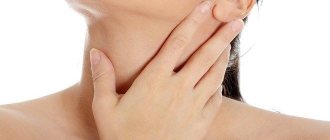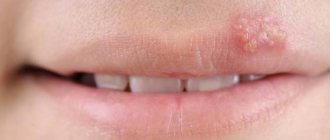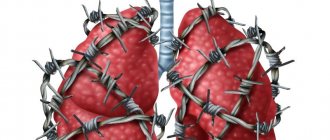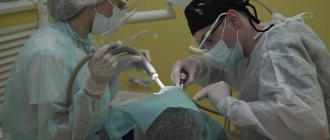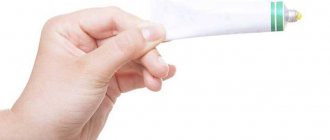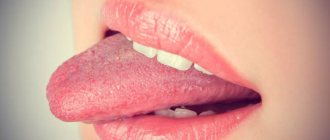What is angioedema of the larynx? Most likely, most respondents not related to medicine will not be able to answer this question. But if you voice another name for this condition - Quincke's edema - everything will fall into place.
Angioedema of the larynx is an acute, rapidly developing edema of the deep layers of the skin, subcutaneous tissue and mucous membrane. Angioedema of the larynx is very dangerous, because in the absence of emergency help, the airways can completely block, leading to asphyxia and death.
Angioedema of the larynx is an aggressive reaction of the body to external stimuli. When interacting with an external factor, the body releases biologically active substances into the blood as protective measures - histamine, bradykinin, etc. This whole process occurs with the expansion of blood vessels and an increase in their permeability. Ultimately, the lymph from the capillaries leaks into nearby tissues, causing severe swelling. The mechanism of angioedema formation is similar to the appearance of allergic urticaria. Only in the latter case, the vessels dilate in the upper layers of the skin, so urticaria is not dangerous, but in case of angioedema of the larynx - in the deep layers of the skin.
This is a relatively new medical condition. It was first described in his works at the end of the 19th century by the German physician Heinrich Quincke. Swelling of the throat develops very quickly - several hours or even minutes can pass from the moment of interaction with the irritant. Therefore, treatment and assistance for swelling of the throat should be urgent.
Symptoms of Quincke's edema.
The first sensations that a person experiences are a burning sensation and a slight tingling sensation at the site of future swelling. Then swelling occurs. Dangerous swelling appears on the face (lips, eyelids, cheeks) and neck. The tongue is very swollen. It gets to the point where a person’s face becomes like a ball, and the patient is not even able to fully open his eyes.
In the first minutes after interaction with the irritant, symptoms may appear in adults and children, such as lacrimation, problems breathing through the nose, the appearance of a dry cough and hoarseness in the voice. Another important symptom of angioedema of the throat is “wheezing”, heavy breathing. All these symptoms very quickly gain momentum and become intense. It’s as if a person was bitten by a swarm of bees - this is what angioedema looks like externally.
In addition to external changes, this dangerous condition has other symptoms: decreased blood pressure, excessive sweating, and rapid heartbeat.
Angioedema of the larynx is the most dangerous manifestation of angioedema, when swelling affects the throat and airways. An emerging cough, sore throat, difficulty swallowing, a feeling of a lump in the throat, problems with speech - all these symptoms indicate incipient asphyxia (suffocation).
When the first symptoms of Quincke's edema appear, you need to call an ambulance so as not to waste precious time. If the swelling of the larynx is not relieved soon, the person may die. Even if death was avoided and treatment of angioedema was not delayed, prolonged absence of normal breathing can lead to damage to brain activity.
How to quickly relieve facial swelling in adults
If this is physiological swelling of the face, not associated with serious pathologies that require medical supervision and the use of selected medications, excess fluid can be eliminated through certain simple measures and actions.
Taking a contrast shower or washing with cold/hot water. This method refreshes, increases tissue tone, enhances the outflow of fluid from the skin and reduces swelling.
Using ice – a couple of pieces of ice will help deal with swelling on the face quickly and effectively. In addition, you can prepare herbal decoctions with a tonic effect in advance and freeze them, using them for washing.
Facial massage is an effective remedy that helps improve microcirculation and swelling. Manual massage, the use of rollers, ice cubes, and cold spoons help. Sometimes you can first wipe your face with green tea and apply compresses with it to your face and eye area.
Causes of laryngeal edema.
In addition to knowing about the first signs of angioedema, you need to understand why, in principle, this dangerous condition can arise.
Typically, angioedema is of an allergic nature, but there are cases when the human body is affected not by allergens, but by other external factors.
The most common causes of angioedema of the larynx are:
- certain foods (for example, eggs, chocolate, etc.);
- plant pollen during the flowering period;
- fungi;
- household chemicals;
- taking medications;
- insect bites;
- dust;
- pet hair or excretions;
- exposure to open sun;
- hypothermia;
- stressful situations;
- digestive problems;
- heredity.
Types of edema.
There are several types of Quincke's edema.
Angioedema can be hereditary or acquired. Hereditary angioedema is a rare genetic disease that was first described at the end of the 19th century and is characterized by recurrent edema. If a mother or father has this diagnosis, the probability that their child will be born with the same diagnosis is 50%. With timely prevention and proper treatment, the patient’s attacks rarely occur, and the patient lives quite well with this diagnosis. Cases of acquired disease are quite small, and are most often observed in elderly patients.
Depending on the cause that caused Quincke's edema, allergic, non-allergic and idiopathic edema are distinguished when the cause of the condition could not be determined.
Sprays and drops
Since the treatment must be comprehensive, a nasal spray acts as an additional antiallergic agent. After reading customer reviews, we have compiled a rating of the TOP 3 remedies against allergic rhinitis.
| Name | Type of drug | pros |
| Tizin Alerji | Vasoconstrictor | Fast action, long lasting results, no side effects. A small single dose is required, so the drug is economical. Approved for use by children and pregnant women. |
| Avamis (adults only) | Hormone | Reduces the inflammatory effect, lasts for at least eight hours. |
| Allergodil | Antihistamine | Does not contain hormonal substances. The drug can be used as a prophylaxis. |
To eliminate itching and watery eyes, as well as conjunctivitis, special drops are prescribed. Let's look at the best products, according to buyers.
| Name | Type of drug | pros |
| Visine | Vasoconstrictor | Quickly relieves swelling and inflammation, allowed for children from two years of age. |
| Allomide | Antihistamine | Blocks the first type of receptors. The drug is used in the treatment of conjunctivitis, as well as as a prophylaxis. |
| Diclofenac | Non-steroidal | The drug relieves inflammation and has an analgesic effect. Eliminates lacrimation. |
First aid for Quincke's edema.
How to relieve Quincke's edema? The first thing you should do when you find yourself next to a person with signs of angioedema is to call an ambulance.
What to do in case of Quincke's edema before the doctors arrive?
- First, unbutton the patient's clothes, loosen the tie, remove chains, beads, etc., thereby ensuring air flow. If you are indoors, open a window to let fresh air in.
- Make the patient more comfortable and try to calm him down by saying that doctors will arrive soon and begin treatment. This condition puts the patient into shock, which only worsens respiratory failure.
- If the problem began due to contact with an allergen, eliminate it if possible.
- Give the patient a tablet of any antihistamine that is in your home medicine cabinet. If the person cannot swallow, crush the tablet and place it under the person's tongue.
- Give the patient food more often if he can swallow, preferably with mineral water.
- If swelling is caused by contact with an allergen, give the patient activated carbon, Enterosgel or Polysorb to reduce the concentration of the allergic substance in the body.
- The patient's feet should be kept warm. You can place them in a bath of warm water or wrap them well.
- Place any vasoconstrictor drops into the patient's nose.
- It is necessary to measure the patient's blood pressure, and if it falls below 90, it is necessary to administer adrenaline to the patient.
Even if the patient feels better as a result of the measures provided, under no circumstances should one refuse medical care.
Treatment of rhinitis in acute respiratory viral infections with first generation antihistamines
The most common causes of respiratory system diseases are acute respiratory viral infections (ARVI). According to the World Health Organization, an adult experiences ARVI twice a year. In children, the incidence of ARVI is on average 3 times higher than in adults. Temporary disability of the adult population due to ARVI in Russia annually accounts for 25-30% of the total temporary disability and causes great economic damage. Patients with ARVI are the main contingent of patients in the clinic, therefore one of the main tasks of the doctor is to reduce the incidence of ARVI and reduce the period of temporary disability, and this can only be achieved with timely detection and, most importantly, with optimal treatment of this category of patients.
The ARVI group consists of etiologically independent diseases, the most important of which are influenza, parainfluenza, RS virus, rhinovirus and adenovirus infection; They are united by two main features: a single mechanism of pathogen transmission and similar clinical manifestations of the infectious process.
Indeed, different groups of respiratory viruses can cause almost identical lesions, but an etiological diagnosis can only be made based on the results of serological diagnosis, performed only in order to control the epidemiological situation, which, unfortunately, is not always achievable in an outpatient setting.
One of the main and most important manifestations of most acute respiratory viral infections is rhinitis. The International Rhinitis Group defines it as “inflammation of the nasal mucosa, characterized by one or more symptoms: nasal congestion, rhinorrhea, sneezing, nasal itching.” Typically, the disease debuts with the appearance of malaise, a feeling of dryness in the nose, and sneezing. Then swelling of the nasal mucosa quickly increases, and rhinorrhea appears.
Therapeutic tactics depend on the severity of the pathological process. If the course of the disease is fairly mild and there is no threat of complications, it is advisable to use non-drug treatment methods (steam inhalations, rinses, hot foot baths, dry heat on the lower back and feet, diaphoretic procedures), and vitamin therapy is indicated. With pronounced symptoms of acute rhinitis, the patient’s general well-being suffers, his performance decreases, and his quality of life deteriorates. Due to swelling of the mucous membrane of the paranasal sinuses and Eustachian tubes, a headache appears in the forehead and a feeling of congestion in the ears. There may be narrowing or blockage of the nasolacrimal canal, which is manifested by profuse lacrimation, painful swelling of the lacrimal sac, and there is a threat of complications from the paranasal sinuses and middle ear. It is the likelihood of the process becoming chronic and developing complications that justifies the advisability of using medications for acute rhinitis. However, it is necessary to take into account the peculiarities of the psychology of the majority of patients who prefer to use one, maximum two “all-healing” remedies. Prescribing 3-4 medications that must be taken several times a day leads to the patient beginning to doubt the correctness of the doctor’s prescriptions, violate the medication regimen, and as a result, the effectiveness of treatment decreases. Thus, in outpatient practice, it can be considered most preferable to prescribe drugs that have a sufficient breadth of therapeutic action, relieve the main symptoms of the disease, cover pathogenetically significant paths of its development and allow minimizing the amount of medication taken.
Being a permanent component of almost all organs, tissues, fluids and secretions of the human body, histamine mediates its physiological and pathological effects through three types of membrane receptors (H1, H2, H3) located on the smooth muscle cells of internal organs and blood vessels, endothelial cells , nerve endings, peripheral blood leukocytes. Contraction of smooth muscles, increased vascular permeability, increased mucus secretion in the upper respiratory tract, increased intracellular concentration of cGMP, pulmonary vasoconstriction, increased chemotaxis of eosinophils and neutrophils, increased production of thromboxane, prostaglandins F2a, E2 and similar arachidonic acid derivatives are realized through the activation of H1-histamine receptors [ 12].
The need to eliminate the pathological effects of histamine led to the search and then the introduction into clinical practice of drugs that competitively block H1-histamine receptors. However, the term “antihistamine” does not fully reflect the essence of these drugs, since they cause a number of other pharmacological effects. This is partly due to the structural proximity of such local hormones as histamine, adrenaline, serotonin and acetylcholine: a substance that eliminates the effects of one stimulant can block the effect of another [3]. The accompanying pharmacological effects of first-generation antihistamines were considered undesirable, which led to the introduction of the following generations of antihistamines into clinical practice. However, first generation H1 blockers, which have anticholinergic properties, have found use as mediator therapy for acute respiratory viral infections.
The use of first-generation antihistamines brompheniramine, chlorpheniramine, chloropyramine for ARVI, in contrast to second-generation H1-blockers, highly effectively reduces symptoms of rhinitis such as swelling of the mucous membrane and nasal congestion, rhinorrhea, sneezing and itching in the nose [5-8]. The mechanisms of action of first generation antihistamines are associated both with their ability to block H1-histamine receptors and with competitive antagonism of muscarinic receptors, which mediate parasympathetic stimulation of glandular secretion and vasodilation. In addition, due to the ability of these drugs to penetrate the blood-brain barrier, they affect the corresponding receptor formations in the medulla oblongata and hypothalamus [9].
The overall assessment of the effectiveness of ARVI treatment, independently carried out by patients and attending physicians on a 4-point scale (0 - no effect, 1 - moderate effect, 2 - good effect, 3 - excellent effect), when using Suprastin, averages 2.6 points, which significantly exceeds the same indicator in the group of patients who did not use suprastin (1.9 points).
Thus, first generation antihistamines (for example, suprastin) are highly effective drugs and can be recommended for symptomatic and pathogenetic therapy of rhinitis in acute respiratory viral infections. Small dosages and the possibility of prescribing drugs in short courses make it possible to avoid side effects or minimize them [4].
Literature
- Clinical immunology and allergology/Under. ed. L. Yeager. M.: Medicine, 1990. T. 1. P. 155-156.
- Kotova S. L., Berezhnaya N. M. Intracellular regulation of the interaction of histamine with receptors in normal conditions and in atopy // Immunology. M.: Medicine, 1992. No. 5. P. 4-7.
- Lawrence D. R., Bennit P. N. Clinical pharmacology. M.: Medicine, 1991. T. 2. P. 486-491.
- Bender BG, McCormick DR, Mildrom H. Children's school performance is not imparied by short-term administration of diphenhydramine or loratadine//J. Pediatr. 2001. Vol. 138(5). P. 656-660.
- Gaffey MJ, Kaiser DL, Hayden FG Ineffectiveness of oral terfenadine in natural colds: evidence against histamine as a mediator of common cold symptoms//Pediatr. Infect. Dis. J. 1988. Vol. 7(3). P. 223-228.
- Gwaltney JM, Jr., Druce HM Efficacy of brompheniramine maleate for the treatment of rhinovirus colds//Clinical Infectious Diseases, 1997. Vol. 25. P. 1188-1194.
- Gwaltney JM, Jr., Park J., Paul RA, Edelman DA, O'Connor RR, Turner RB Randomized controlled trial of clemastine fumarate for treatment of experimental rhinovirus colds//Clinical Infectious Diseases. 1996. Vol. 22. P. 656-662.
- Gwaltney JM Jr., Winter B., Partie JT, Hendley JO Combined antiviral-antimediator treatment for the common cold//J. Infect. Dis., 2002. Vol. 186(2). P. 147-154.
- Muether PS, Gwaltney JM, Jr. Variant effect of first- and second-generation antihistamines as clues to their mechanism of action on the sneeze reflex in the common cold //Clinical Infectious Diseases. 2001. Vol. 33. P. 1483-1488.
A. A. Stremoukhov, Doctor of Medical Sciences E. B. Mishchenko, Candidate of Medical Sciences
MMA im. I. M. Sechenova, Moscow
In practice, to relieve the symptoms of rhinitis during ARVI, the most preferable is the use of chloropyramine (suprastin). According to our data, the administration of Suprastin twice a day at a daily dose of 50 mg (25 mg per dose) for 5 days, starting from the first day of the disease, allows already on the second day of taking the drug to reduce congestion and nasal discharge, in addition, the patient begins to sneeze less often. On the 4th–5th day of treatment with suprastin, nasal breathing is practically restored, nasal discharge, sneezing and itching in the nose stop (see figure).
| Dynamics of rhinitis symptoms during treatment with suprastin (own data) |
Our analysis of the dynamics of the disease in groups comparable in gender, age and nature of the pathological process showed that in patients receiving Suprastin, rhinitis symptoms regress 1.6 - 2.3 times faster. As the manifestations of rhinitis are relieved, the patient’s general condition improves, the intensity of the sore throat decreases, and the severity of the cough syndrome caused by the flow of discharge from the nasal cavity into the larynx and trachea decreases. In addition, the use of Suprastin makes it possible not to resort to the use of nasal vasoconstrictor drugs, which, with prolonged use, in some cases can themselves cause drug-induced rhinitis. Patients already using nasal decongestants can significantly reduce the frequency of their use.
Treatment of angioedema of the larynx.
Treatment of angioedema consists of two stages. The first is emergency care, the second is hospital treatment. Before starting treatment, the cause of angioedema is determined, and then a treatment regimen is prescribed. This may include:
- taking antihistamines (“Suprastin”, “Loratadine”, “Tavegil”);
- corticosteroid drugs (for example, Prednisolone, Dexamethasone, Nasonex, Celeston);
- diuretics (for example, Furosemide);
- enterosorbents for removing allergens and toxins (for example, Multisorb);
- enzyme preparations (“Pancreatin”, “Festal”);
- administration of a C1 inhibitor, a blood protein whose deficiency leads to non-allergic angioedema;
- administration of fresh frozen plasma (for non-allergic edema);
- administration of androgens - sex hormone preparations (for non-allergic edema).
